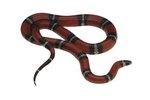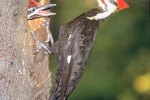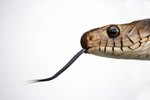
Fourteen species of snakes live in Connecticut, including two that inject venom when they bite. While some species are located within a limited range, the majority are found all over this relatively small state. Because of development and habitat loss, some once-common Connecticut snake species are increasingly hard to find.
Water Snakes
Only two of Connecticut's snake species live primarily in water. The northern water snake (Nerodia sipedon) is a heavy-bodied dark snake with reddish bands. Found throughout the state, northern water snakes dwell in any sort of natural water source. The increasingly rare Easter ribbon snake (Thamnophis sauritus) is a thin, dark snake with three yellow stripes on the side. It eats worms, fish and amphibians.
Small Snakes
Most of Connecticut's snakes fall on the smaller side, less than 2 feet in length. These include the northern brown snake (Storeria dekayi). This snake is often found in urban areas, where it primarily subsists on worms. The smooth green snake (Liochlorophis vernalis) eats bugs. The familiar eastern garter snake (Thamnophis sirtalis), frequently found in suburban backyards, consumes just about anything edible it comes across. The brown eastern worm snake (Carphophis amoenus) is fairly rare in Connecticut. The northern redbelly (Storeria occipitomaculata) is a brown, slug-eating snake with a bright red underside. The easily identified northern ringneck snake (Diadophis punctatus edwardsii) has a gray or black body with a yellow band around its neck. It eats salamanders, frogs and other amphibians.
Black Snakes
Two primarily black snakes are Connecticut natives. The northern black racer (Coluber constrictor) matures at 5 feet or more. While the numbers of northern black racers are on the decline in the state, the black rat snake's numbers are increasing. Elaphe obsoleta is even bigger than the northern black racer -- it's the largest snake in Connecticut, reaching lengths of 6 feet or more. Because of its rodent-killing abilities, many farmers welcome the presence of the black rat snake. It also eats birds, eggs and amphibians.
Venomous Snakes
Two venomous snakes live in the Nutmeg State, although both are relatively rare. The timber rattlesnake (Crotalus horridus) resides in deciduous forests with rock outcroppings in the vicinity. Timber rattlesnakes create dens along rock ledges. This large, brownish-gray snake with yellow or white bands consumes birds and small rodents. The smaller northern copperhead (Agkistrodon contortrix mokasen) boasts a light brown body with dark red or brown bands. Usually found near water, they also live on rock ledges. The northern copperhead's diet consists primarily of rodents, small reptiles, amphibians, insects and birds.
Mistaken Identity
The eastern milk snake (Lampropeltis triangulum) has the bad luck to resemble the northern copperhead. For that reason, it's often killed by people afraid that this non-venomous snake will attack. The rare eastern hognose snake (Heterodon platirhinos) is also mistaken for the northern copperhead. If threatened, the eastern hognose pretends to be dead and releases a bad smell to ward off predators.
References
- Connecticut Department of Energy and Environmental Protection: Snakes
- State of Connecticut Wildlife Bureau: Venomous Snakes of Connecticut
- Connecticut Department of Energy and Environmental Protection: Snakes in Connecticut
- Yale Peabody Museum of Natural History: Online Guide to the Amphibians and Reptiles of Connecticut
Photo Credits
-
Jupiterimages/Photos.com/Getty Images
Writer Bio
Jane Meggitt has been a writer for more than 20 years. In addition to reporting for a major newspaper chain, she has been published in "Horse News," "Suburban Classic," "Hoof Beats," "Equine Journal" and other publications. She has a Bachelor of Arts in English from New York University and an Associate of Arts from the American Academy of Dramatics Arts, New York City.



